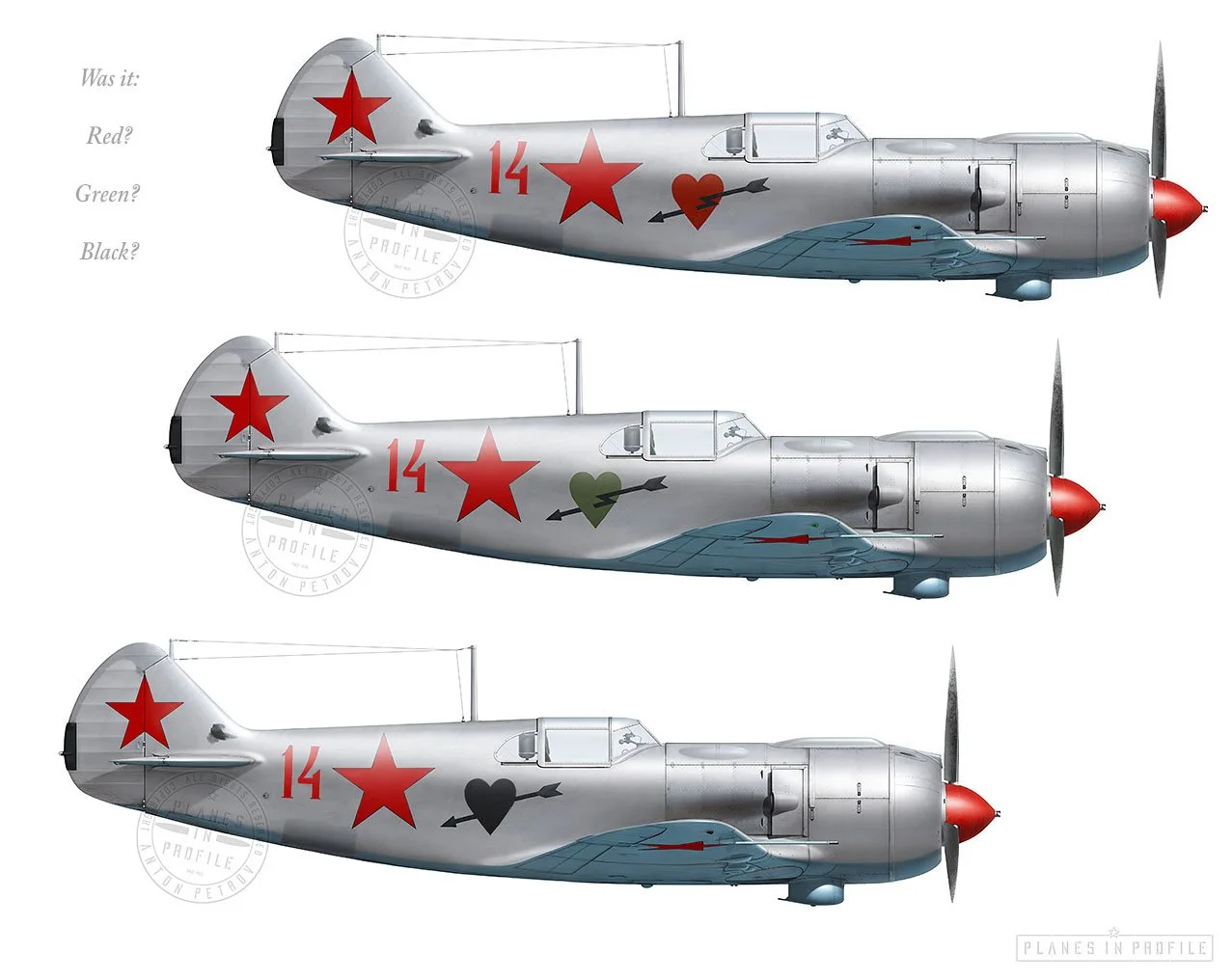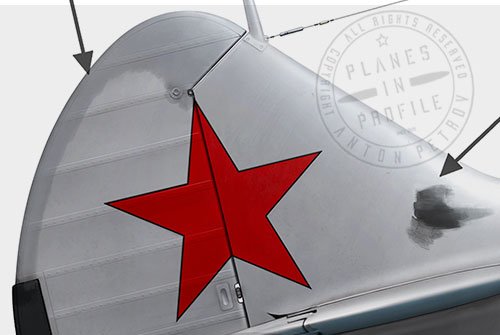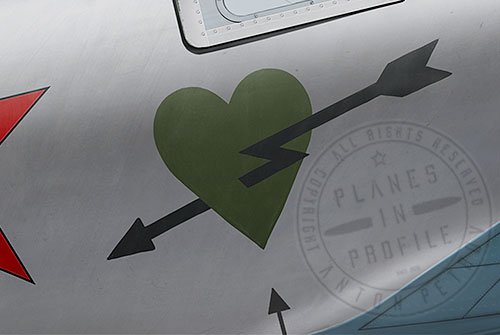Red?-14, “Stricken heart”
LAVOCHKIN, LA-5 (TYPE 37)
19-th (Red-Bannerd) IAP, 269 IAD, 2-nd Air Army, Voronezh Front, circa Yelets, Russia, circa Jan-March 1943.
Flown by an unknown pilot.
19th IAP (which in August 1944 became the famed 176th GIAP) began its formation on March 22, 1938 in Gorelovo, in the Leningrad region. The regiment consisted of pilots who fought in the Spanish Civil War and was a unit assigned with execution of special tasks of the Soviet Government and the military command.
The regiment took part in the battles of Khalkhin-Gol in Mongolia and then in the Soviet-Finnish war of 1939, earning itself the Order of the Red Banner decoration for its achievements in the latter conflict.
When Operation Barbarossa began on June 22nd, 1941, the regiment was a part of the Air Force of the Northern Front. From the 8th of August 1941 the regiment was included into the 7-th IAK PVO and took part in defending the city of Leningrad until December 1941. During that time period the regiment flew 3145 battle sorties, engaged in 415 air battles and shot down 116 enemy airplanes, while losing 30 pilots and 57 airplanes of its own.
After recuperating from the intense battles experienced in the Leningrad region, the regiment was back in action once again from the period of 25-th Feb to 26-th of April 1942, this time fighting on Volhovskiy Front, taking part in the Luban Offensive Operation.
During these first two periods of fighting in the Great Patriotic War, the regiment often engaged in air battles with the enemy fighters of the infamous Jagdgeschwader 54, the ‘Grunherz’ (Green Hearts). This German unit was the second-highest scoring wing of the Luftwaffe and included some of the world’s top-scoring fighter Aces, such as Otto Kittel ( future, World’s 4-th highest-scoring Ace and top FW-190 Ace), Walter Nowotniy (Future 5-th top scoring Ace), Hans-Ekkehard Bob, Max-Helmuth Ostermann, and Hannes Trautloft. A truly formidable adversary in air battles.
On the 10-th of September 1942 the 19-th IAP was moved south to its new base in Lyubertsi. At this time the regiment was still flying the MiG-3 and the LaGG-3 fighters.
At the end of October 1942, 19th IAP received its first La-5 airplanes. It spent the next couple of months training to fly these.
In December 1942, the regiment was moved from Lyubertsy to the Yelets area with 39 crew armed with La-5 aircraft, and began combat work once again from January 2, 1943 to 19 March , 1943. During this time the regiment took part in the counteroffensive at Stalingrad, as well as in the Ostrogozhsko-Rossoshansk, Voronezh-Kastornenskaya, Kharkov offensive and Kharkov defensive operations. This is the period during which the photos of Red-14 are presumed to have been taken.
It is a period during which the pilots of the 19-th IAP flew 1,055 sorties, shooting down 35 enemy aircraft in 60 air battles (19 bombers, 11 fighters, 5 reconnaissance aircraft). The regiment lost five of its own La-5s in battles, and five more fighters have crashed. Five pilots were killed, three of them in battle, and two in accidents. The regiment also reported on the destruction of 136 enemy vehicles, about 200 carts, 2 anti-aircraft artillery batteries. On March 20, 1943, the regiment was assigned to the reserve to undergo further upgrading.
On the 6-th of June, 1943, In the ‘Red Star’ newspaper, there appeared an article written by a pilot of the 19-th IAP, (a future Hero of the Soviet Union), Aleksey Konstantinovich Pahomov. The article was called ‘Lavochkin-5’ is fighting. This article was accompanied by an image showing four silver La-5 fighters, the fighter in the foreground Looks like our Red-14. This photo, or photos from which this image was composed, was/were taken by the photocorrespondent, captain O. Knorring, same as all the other photos the links to which are listed below
Pahomov’s article said the following about the La-5 airplanes :
With the appearance of the fighter Lavochkin-5 in our sector of the front, the German pilots immediately became wary. They began to look closely at this machine and at first in every possible way avoided a fight with it, and then, recognizing its qualities, they fought carefully, watchingly.
The battles took place with a varying balance of forces, and often Messerschmitts had a large numerical superiority. In one of such clashes, our fighter pilots, who fought in the La-5, shot down six Me-109s at once, without losing a single plane of our own.
Then it goes on to describe three instances of the achievements by three pilots of 19-th IAP. It describes how Bachilo engaged three Me-109 fighters by himself and shot down two of them, how Shebeko fought off three Me-109s while he was escorting Soviet Il-2s , downing one of the Messerschmitts, and how Azarov was working so beautifully that the people on the ground watching the air battle above were clapping every time he downed a bomber.
After this the article ends in :
To the Lavochkin-5 aircraft, the pilots leading the battle give a truthful and impartial description:
- A simple, not a strict machine. You feel in it like in a sleigh. And if it fires, be sure: only splinters will be left flying from the German.
It is not known if Pahomov, or any of the pilots mentioned above, were the ones who flew the Red-14, though it is quite possible that one of them did.
In months to come, the 19-th IAP took part in the battles of Kursk and other offensive operations including the hugely successful ‘Operation Bagration’. As already mentioned, in August 1944, 19-th IAP was renamed into the well-known 176-th Guards Fighter Aviation Regiment (GIAP) consisting of Soviet Aces dedicated to ‘free-hunting’ missions. This regiment was personally curated by the Chief Marshall of Soviet aviation (Commander of the Air Forces of the Red Army), Alexandr Aleksandrovich Novikov. For this the 176th GIAP got an unofficial nickname of ‘Marshalskiy’ . The regiment was used as a special force, usually sent into the most dangerous hot spots [1]. The Aces of this regiment were hand picked from some of USSR’s best, one of them was a young pilot by the name of Ivan Kozhedub. A pilot with 45 victories at the time he joined the famed 176-th GIAP of free-hunter Aces, a pilot who went on to become the highest-scoring Allied fighter Ace of WW2 (based on personal victories) [2].
Noteworthy Visual Characteristics
Noteworthy Visual Characteristics
Overall, The airplane seems to be painted with ‘aluminium’ colour. This is non-standard for the La-5. Though this livery is quite rare for the La-5, it often appeared on other Soviet fighters such as the Polikarpov I-153 and I-16.
1) There are two areas which have a slightly different tonal value to the rest of the airplane. One is on the edge of the rudder ‘1a’ and the other is on the bottom of the fuselage ‘1b’. Both seem to be the same ‘colour’ based on their comparative tonal value, both appearing light in photo ‘1’ and dark in photo ’2’ below. Because of this change in tonality in the two photos, the colour of these areas might have been freshly painted ‘aluminium/silver’ paint, or some other glossy/reflective colour. This might have been a repair job of some sort, freshly covered with paint.
2) The trimmer looks like it was painted black. It might have been a trimmer from another airplane which had the standard Green/Black camouflage pattern.
3) There is a dark mark at the base of the ‘tail’ in the photo reference. This has been interpreted by people such as Massimo Tessitory as a possible repair job of some sort, touched up with black paint.
One of the complications is in the fact that the group photo of 4 planes is showing that this ‘dark mark’ appears on at least one other airplane. If this mark actually appeared on other planes in the same spot on the tail then this ‘dark mark’ must have been an image of some sort rather than a ‘repair job’ . Most probably an image of the ‘Order of the Red Banner’ (ORB)medal, since this regiment received this order (it was a ‘Red Bannered’ IAP). But when we compare the ORB medal to the close-up of the dark mark it doesn’t seem to match the shape of it.
Knowing that the photo of the 4 planes was tempered with by an artist (this is especially noticeable when looking at the clouds), I believe that the dark mark might have been placed on the other airplane(s) by the artist too. In fact, many such images created for newspapers in the 1940s were not just ‘touched up’ by the artist, but were often created by the artist from scratch, combining various photos into one image. Either way, the photo of the group of 4 planes used in the Red Star newspaper, is not trustworthy in that regard, so I resorted to Massimo Tessitori’s interpretation of this mark being a possible ‘repair job’.
4) Number ‘14’ appears slightly lighter than the star. This might be because it’s thinner than the star and therefore blends in with the surrounding light aluminium colour in the blurry photo. Also the black outline around the star adds some darkness to it, while the numbers painted in the standard font of the early La-5 were usually not outlined, thus might appear lighter because of that too. Red was a common colour to use for the markings on Soviet Planes, so it’s most likely that the number was painted red, but others have suggested that the number might have been light blue instead.
5) The star appears to be positioned a bit further back than usual.
6) Note the dark area in the space which is covered by the sliding part of the canopy when it’s in the ‘closed’ position. This is most likely a part of the original camouflage showing through, left over because this area was impossible to access when the plane was given a coat of aluminium paint.
7)The technical markings on the upper surfaces and the fuselage, might have been overpainted with aluminium paint. This is based on the presumption that Red-14’s aluminium livery was not factory painted, but has undergone a ‘field repainting’ . If the plane was painted aluminium in the factory then the technical markings were probably present/visible.
8) The exhaust panel might have been slightly over-sprayed with aluminium paint, since it appears to have a similar ‘tonal value’ as the aluminium coloured airplane in the b/w photos.
9) The spinner looks to be painted red. The base of the spinner is painted with aluminium colour.
10) The pierced heart might have been an emblem exclusive to Red-14. It doesn’t appear on other planes of the 19-th IAP and it is not clearly noticeable on the other airplanes in the artist-created/adjusted group photo from the Red Star newspaper, except for possibly the ‘third from the bottom’ airplane.
The arrow seems to not be a straight line from tip to tail. It might have actually been a lightning-shaped arrow, similar in shape to the lightnings/arrows of the Lavochkins of the 295-th IAD.
Though the colour of the heart appears to be black in the photo reference, that doesn’t necessarily mean that it was. Here are some arguments for various possible colours:
Red ?) Red is the safest presumption, since it is the usual colour of the heart. Not to mention that ‘red’ is the most “Soviet” of colours.
The reason it appears so dark in the photo reference in comparison to the red stars is because it had undoubtedly been painted some time later and unlike the stars had not had time to weather and fade yet. Often in B/W photos, especially when it comes to fresh (unweathered) paint and especially when viewed against a light background, red appeared as dark as black, as can be seen in the photos below.
It’s not known if the emblem appeared on both sides of the plane. Most of the time, personal emblems (unlike the official regimental emblems), appeared on one side of the plane. But this emblem is a simple one to paint twice, and therefore could have been painted on both sides of the airplane.
Green ? )There is a theory that the heart on Red-14 referred to Luftwaffe’s Jg-54 (Grunhertz). The reason being is because before the 19th IAP was transferred south and received their La-5 airplanes, it used to engage in air battles with the fighters of the infamous Jagdgeschwader-54, Luftwaffe’s famed unit based in the North. The emblem of this unit was a ‘green heart’ . If this was indeed a reference to Jg-54’s ‘Grunhertz’ then it makes sense to presume that Red-14s heart might have been painted green (AMT-4 most likely, the ‘green’ colour of La-5’s camo), The arrow was probably painted black. As with ‘red’ , fresh AMT-4 ‘dark green’ often appeared very dark in b/w photos, though not as dark as ‘Red’, as can be seen in the photos below.
’Green heart’ struck with a black lightning/arrow “of death” would have made sense as an emblem on Red-14.
The ‘Green Heart’ emblem of Jg-54 was painted on both sides of their airplanes. If Red-14’s emblem was referring to that of the Jg-54, then it might have been painted on both sides of the plane also.
Black ?) The argument for ‘black’ colour is the simplest - the heart, undeniably, looks black in the photos of Red-14. But the tonality of colour in the b/w photo can be misleading, because ‘red’ for example, often looked as dark as ‘black’ in b/w photos, as the photos below show. Besides, ‘black’ is not a colour commonly associated with a ‘heart’ and unlike ‘green’ there have been no suggestions for the reasons why the heart might have been painted black. Therefore in terms of ‘meaning’ this is probably the least likely option and in terms of photo reference it’s as likely as, at least, red.
Conclusion) Based on the little that can be confirmed about the colour of the heart, it seems that (fresh)Red is the safest presumption to make and the photo evidence seems to support it.
11) The technical markings on the lower surfaces were probably not painted over because the planes seem to not have been painted ‘aluminium’ on the lower surfaces. The warning on the wheel shields might have read ‘Не Вставать’ which loosely translates to ‘Don’t get up (on top of) ’. This seems to have been more common to the early La-5 planes than the other variation of this warning which is ‘Не Становиться’ (loosely translates to ‘Don’t stand on’ ) which was more common to the later La-5 modifications.
Here are a few close-up images to help illustrate the points above. Full set of close-up images is On Patreon
Footnotes
Much of the info in the ‘HISTORY’ section is based on the Russian Wikipedia entry about the 19th IAP and entry about Jg-54.
[1] This is based on the information in a video called ‘Legendary airplanes: La-5 (Part 1), timestamped 33:11 - 33:46
[2] According to M. Bykov’s research published in his book called ‘Все Асы Сталина’ (All Aces of Stalin), Ivan Kozhedub had 64 personal victories and 0 shared victories. His total victory score is second only to Grigoriy Rechkalov, 61 personal and 4 shared victories (65 total) . Based on personal victories Kozhedub is the highest scoring Allied ace.
‘Все Асы Сталина’ (All Aces of Stalin), by M.Bykov, Published by Yauza in 2014, page 550-551 and 1000-1001
Summary of LINKS TO THE REFERENCE IMAGES AND VIDEOS
For reference images and an alternative interpretation of this airplane’s paint scheme, please visit SovietWarPlanes.com http://massimotessitori.altervista.org/sovietwarplanes/pages/la5/la5/piercedheart/piercedheart..html
To go directly to the reference images click below:
Image 1
http://massimotessitori.altervista.org/sovietwarplanes/pages/la5/la5/piercedheart/piercedheart3.jpg
Image 2
http://massimotessitori.altervista.org/sovietwarplanes/pages/la5/la5/piercedheart/piercedheart.jpg
Image 3
http://massimotessitori.altervista.org/sovietwarplanes/pages/la5/la5/piercedheart/piercedheart.jpg
Image with the article from the ‘Red Star’ newspaper, 6-th of June, 1943
http://scalemodels.ru/images/2019/11/1573495239_la-5-s-serdcem-krzv-06-06-1943.jpg
All photos above belong to Petr Zaika.
All the work presented on this is page is subject to updates and revisions in the light of new information which might present itself. If you have any new information relevant to this page or disagree with anything that's presented here, then please feel free to contact me through the Planes in Profile Facebook page. Thanks:)
Special thanks to Petr Zaika for providing additional information associated with this airplane and for allowing the use of parts of his photos in the ‘Noteworthy Visual Characteristics’ section.
Special thanks to Aleksandr Kazakov and Igor Zlobin for their comments/arguments about the colour of Red-14’s heart.










